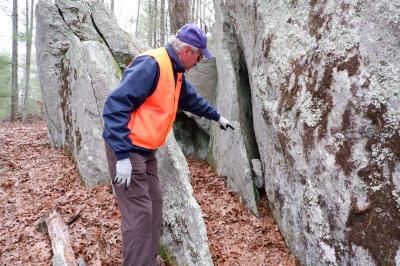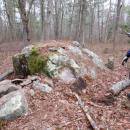Rochester rocks: Documenting Native American stone structures
Overcast skies, near freezing temperatures and a cold breeze might not seem like friendly conditions for most — but for Rochester resident Stephen DiMarzo, that weather is perfect.
Those cold temperatures and cloudy skies make for the best days for DiMarzo to pursue his hobby: Documenting Native American rock structures.
He spends hours out in the woods in his backyard and on trails he has permission to use, equipped with a pistol to ward off coyotes, wolves and “unruly people” — though he said he’s never had to use it.
Last year, he documented 925 different structures across three states.
“I just want to bring to light some of the work that was done,” DiMarzo said.
It all started when he was listening to a radio show, and became interested in the documentation of Norse structures. He and his brother eventually began documenting nearby Native American structures for themselves. And while his brother eventually fell out of the hobby, DiMarzo has kept on, documenting countless structures over the years.
DiMarzo walks through the woods videoing and photographing the structures he’s found and compiles his findings into videos, which are sometimes nearly 20 minutes long.
Those cloudy cold days are the best days for documenting, according to DiMarzo. That’s when the lighting is the most even, and the ground is the easiest to work with.
He uses tools to clear the structures of branches and dirt so he can photograph and videotape them, but he said the hobby is a lot more than just field clearing.
For DiMarzo, it’s about doing his part to honor the artwork and culture of indiginous people.
“I bring back to life, in essence, what these structures look like, DiMarzo said.
And as soon as he’s done documenting, he puts the dirt and branches right back on the structures, keeping with his “do no harm” mantra.
The videos and photos from DiMarzo’s documenting days are then sent to Mary and James Gage, historians who use the information DiMarzo gathers to do site evaluations and document the history of the land of the Northeastern U.S.
The structures DiMarzo documents have even made it into the Gages’ 2020 book, Land of a Thousand Cairns: Revival of Old-Style Ceremonies, Second Edition.
The book documents the history of a small community of Native people in Rhode Island who had assimilated in many ways to the lifestyle of colonizers to avoid further racism and discrimination — while still passing down their cultural traditions from generation to generation.
“Steve’s work is really absolutely crucial,” James Gage said, adding that DiMarzo’s helped uncover much of the history needed to write the book.
The historian even said that DiMarzo’s dedication to the work surpasses that of many professors — and even some tribal preservationists.
DiMarzo’s style of documentation has been added to the Gages’ website, stonestructures.org, as a template for how land owners and others can do their own site documentations.
Gage said that documentation can really help with informing land owners of the history of their land, and maybe urge them to be more careful about how they go about things like tree removal.
“We’re losing lots of sites to development, unfortunately,” the historian said.
Many of the structures DiMarzo documents in Rochester, though, are somewhat shrouded in mystery. From rounded structures thought to be used for prayer to footholes in rocks that look more deliberate than natural, DiMarzo works with the Gages to decipher the meaning and purpose of the structures.
“A lot of this is just guesswork,” DiMarzo said.
He was especially fixated on certain structures where a small rock or collection of rocks have been placed on top of a large boulder.
“Why all the effort for one stone?” he asked.
Some of the structures, DiMarzo said, are still works in progress.
Whatever their true significance, DiMarzo said some of the structures seem to have been added to as time goes on. Some of the structures are placed on the ground to mimic the arrangement of stars in the night sky, others could be religious tributes, offering thanks for good harvests.
The times when he’s been able to talk with tribe members who might know more about the structures, DiMarzo said it can take some convincing to show his interest in Native culture as a white man is in earnest.
“Why are you doing this? What do you want?” he is sometimes asked.
But DiMarzo said it all comes from a place of admiration for Native culture and proving he’s not the same as his ancestors — some of whom sold indiginous people into slavery.
“I am not made in the same light or in the same vein as my ancestors,” he said.
Despite the mystery surrounding the structures he documents, DiMarzo has learned one thing: “We were the savages.”




















